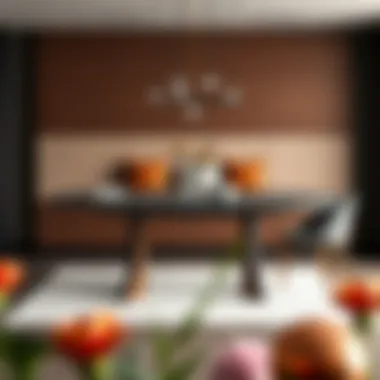Exploring the Ingo Dining Table: Functionality Meets Style


Intro
The Ingo dining table stands out as a cornerstone of modern interior design, harmonizing the demands of functionality with the flair of aesthetics. It’s not merely a piece of furniture; it’s an invitation to gather, share, and partake in daily meals or festive occasions. As homes evolve into multi-functional spaces, understanding the intricate beauty and practicality of the Ingo dining table becomes essential for designers, homeowners, and decorators alike. This article sheds light on this captivating piece, delving into its distinctive materials, dimensions, and design influences that shape today’s dining experiences.
In the ever-changing landscape of home decor, the Ingo dining table presents a compelling choice, marrying contemporary trends with timeless elegance. A table isn’t just where meals are served; it is the heart of a home, a stage for conversations and connections. Let’s embark on this journey to explore the Ingo dining table, examining not just its physical attributes but also its significant role in creating an atmosphere that resonates with style and comfort.
Furniture Design Styles
The world of furniture design is rich with diverse styles, each telling its own unique story. To appreciate the Ingo dining table fully, it's crucial to understand the surrounding design styles that can elevate its presence.
Overview of Popular Styles
- Scandinavian: Characterized by minimalism and functionality, this style often features light woods and neutral colors, setting a serene backdrop for the Ingo table, which can either complement or contrast these elements beautifully.
- Mid-Century Modern: This iconic aesthetic embraces leggy designs and organic forms. The Ingo dining table, with its clean lines, finds a natural fit within this genre, establishing an effortless blend of form and function.
- Industrial: Raw materials and unrefined finishes define industrial style. The Ingo can harmonize with elements like metal accents or wood beams, creating a striking juxtaposition.
- Rustic: Think of warm woods and natural textures. An Ingo table with a rustic finish introduces an inviting warmth to any dining environment, providing a perfect meeting of the old and the new.
How to Mix and Match Styles
Mixing and matching styles can yield an eclectic yet cohesive dining space. Here are some tips:
- Contrast Textures: Pair the smooth surface of an Ingo table with textured seating for visual interest.
- Color Coordination: Choose colors that complement each other, like a light wood Ingo table set against dark chairs.
- Layer with Accessories: Use rugs, centerpieces, or tableware that embody different styles, rounding out the dining experience.
"The Ingo dining table can be a versatile canvas, allowing room for creativity and personal expression within various design styles."
Practical Tips for Homeowners
Selecting the perfect dining table is only part of the equation. Ensuring it suits your lifestyle requires consideration on the practical side as well.
Essential Buying Tips
When choosing an Ingo dining table, keep the following in mind:
- Size Matters: Measure your space. The Ingo is available in various dimensions to suit both spacious areas and intimate nooks.
- Material Selection: Focus on durability. Wood varieties such as oak and walnut are popular for their longevity.
- Style Consistency: Ensure that the table aligns with your existing decor to maintain a harmonious flow in the space.
Maintenance and Care Guidelines
Once you've settled on your table, maintaining its beauty is vital:
- Regular Cleaning: Dust it frequently with a soft, damp cloth. Avoid harsh chemicals that can damage the finish.
- Avoid Heat Damage: Use coasters or mats to protect the surface from hot dishes.
- Periodic Conditioning: Apply wood oil or polish every few months to keep the finish looking new.
In summary, the Ingo dining table is not just a piece of furniture; it's a vital element that can enhance your dining experience and reflect your personal style. By understanding its design options and maintaining its integrity, homeowners and designers can create a space that is as functional as it is enchanting.
For more insight on furniture design, check out Wikipedia or explore discussions on Reddit to connect with fellow design enthusiasts.
Intro to the Ingo Dining Table
The Ingo dining table represents a significant intersection of style and practicality, making it a focal point in contemporary design discourse. It’s not your run-of-the-mill dining table; it’s a thoughtfully crafted piece that blends intimate functionality with visual appeal. More than just a surface for meals, the Ingo dining table serves as a gathering space, a backdrop for family interactions, and an exhibit of personal design choices.
When considering the essentials of home furnishings, the dining table undeniably stands as a critical investment. Its role extends beyond mere functionality to encompass aesthetic contributions to the overall living space. For both designers and homeowners, understanding the essence of the Ingo table is crucial. It provides insights into how one can curate an inviting environment where memories are created.
This table's design philosophy roots itself firmly in historical context while maintaining responsiveness to modern demands. Incorporating the latest materials and trends, what sets the Ingo apart is its capacity to adapt. Its versatility means that it suits various interior styles, from minimalist to eclectic, making it a staple in diverse households.
Historical Context
The story of the Ingo dining table traces back to a blend of traditions and innovations that have shaped furniture design over decades. In many cultures, the dining table has served as the centerpiece of family life—a hotbed of storytelling and bonding over shared meals. The evolution of materials—from heavy, cumbersome wood constructions of centuries past to lighter, more versatile designs seen today—reflects not only changing tastes but also advancements in craftsmanship.
In fact, many larger trends in furniture design, such as the shift towards open-concept living spaces, have influenced how tables like the Ingo are conceptualized. The functional aspect of a table has extended to embodying a space for creativity, a theme core to modern design narratives. The Ingo's roots are planted firmly in this fertile setting, drawing inspiration from both traditional forms and contemporary innovations.
Design Philosophy
The design philosophy behind the Ingo dining table hinges on a juxtaposition of utility and beauty, embodying a principle that design should enhance everyday experiences. At its core, this table champions minimalism—focusing on clean lines and uncomplicated forms that diminish visual clutter and promote a sense of harmony in the home.
This philosophy also prioritizes user-centric design, meaning that every curve and edge has purpose. The table is designed for comfort, with heights that accommodate a range of dining chairs and surfaces that invite interaction and usability. These elements unite to create an inclusive experience, ensuring that the dining area becomes a welcoming hub.
Moreover, there’s an emphasis on sustainability, reflecting growing industry awareness regarding environmental concerns. The Ingo dining table employs sustainable materials without compromising aesthetics, foreseeing a future where shopping choices are influenced by ecological impacts.
In sum, the Ingo dining table stands as a testament to thoughtful design that respects both the heritage of dining furniture and the contemporary need for adaptability. It's not merely a piece of furniture; it’s a canvas for life’s moments, crafted for those who appreciate the finer details.
Materials Used in the Ingo Dining Table
The Ingo Dining Table is not just a piece of furniture; it is a statement of style and practicality. The materials used in its construction play a significant role in defining its aesthetic appeal, durability, and overall functionality. Choosing the right materials can enhance one's dining experience while also influencing the table’s resilience over time.
Understanding the characteristics of various materials provides insights into how they contribute to the Ingo's unique identity. Whether one is looking for the warmth of natural wood or the sleek look of metal accents, the material choices for the Ingo Dining Table offer something for every taste and functional requirement.


Wood Varieties
Oak
Oak stands as a favored choice in manufacturing the Ingo Dining Table, celebrated for its robust nature and classic appearance. One of the prominent characteristics of oak is its durability; it withstands daily use, making it ideal for a dining setting that witnesses gatherings and celebrations alike.
A unique feature of oak is its prominent grain patterns that can transform an average table into a bold centerpiece. The tight grain structure of oak also lends itself well to staining, allowing for various finish options without losing its inherent beauty. However, its weight can be a disadvantage if one desires to frequently reposition the table. The stability of oak is a boon for heavy dining items but might pose challenges for smaller spaces requiring mobility.
Maple
Maple is another wood variety that shines in the realm of furniture design. Known for its smooth grain, it offers an elegant surface that seamlessly blends into various interior styles. Its light color and subtle variegation provide a contemporary flair that can brighten any dining room. Maple's resistance to abrasion makes it a practical option for a dining table, as it can withstand the wear and tear of everyday meals.
In comparison to oak, maple is lighter, which enhances its portability. One downside might be its tendency to show scratches more easily than darker woods, which may require more maintenance. Thus, those looking for low upkeep might need to weigh their options carefully.
Walnut
Walnut is often considered the crème de la crème of woods used in crafting dining tables. Its rich and warm tones add a luxurious feel to any room, making it a highly sought-after choice. The deep, dark coloration, coupled with its intricate grain, provides that touch of elegance that can elevate a dining space.
The unique feature of walnut is its ability to age beautifully; over time, the wood develops a lovely patina that only adds to its appeal. Though walnut is a bit on the pricier side, its durability and timeless style justify the investment for many homeowners. On the flip side, its darker color may not suit every decor style and could absorb more heat, so care should be taken concerning placement in sunlit areas.
Metal Accents
Steel
Ingo's versatility can be seen in its incorporation of steel accents, which bring a modern touch. Steel is not only strong but also exceptionally durable, ensuring the structural integrity of the table over many uses. Its ability to resist corrosion and rust makes it ideal for various climates, especially in homes with high humidity.
The sleek lines of steel create a contemporary look which pairs well with wood, making the combination aesthetically pleasing. One downside is that scratch marks can appear, which may be visible depending on the finish. However, the advantages of steel often outweigh these minor drawbacks, especially for a design-oriented audience.
Aluminum
Aluminum is increasingly popular in table design due to its lightweight nature and resistance to corrosion. It is common to find aluminum accents on the Ingo table, enhancing its refined look without weighing it down. This material is especially ideal in homes where flexibility is key, allowing for easy moving and rearranging of furniture.
Its modern appearance aligns well with several decor styles, from minimalistic to industrial chic. A disadvantage, however, is that it may not hold warmth as effectively as more traditional materials, leading to a cooler tabletop. Thus, while aluminum offers aesthetic and functional benefits, one should consider how it fits into their overall dining atmosphere.
Tabletop Finishes
Natural Wood Finish
A natural wood finish on the Ingo Dining Table enhances its wood grain and brings its beauty to the forefront. This finish retains the original characteristics of the wood, showcasing its colors and patterns while providing a protective layer against spills and stains. Homeowners often prefer this finish for its authenticity and simplicity, making it a great choice.
The inherent beauty of natural wood finishes allows the table to blend into various design aesthetics seamlessly. However, this finish may require regular maintenance to keep it looking fresh. It’s best suited for those who appreciate the rustic charm of wood and are willing to provide the needed care.
Laminate Options
For those seeking durability without compromising style, laminate options offer an impressive array of colors and patterns. Laminated surfaces are resistant to scratches and stains, which suits busy households perfectly. They can mimic the look of wood or come in vibrant colors, providing endless possibilities for styling.
One key feature of laminate is its ease of cleaning—a quick wipe can take care of most spills. Nevertheless, laminate surfaces can lack warmth compared to natural wood, making them less inviting for some. Hence, individuals should consider what ambiance they want to create within their dining area when choosing this option.
In summary, the choice of materials for the Ingo Dining Table plays a pivotal role in its design and function. From robust woods like oak, maple, and walnut to the sleekness of steel and aluminum, each option has something unique to offer. The finishes add the finishing touch, allowing homeowners to tailor their tables to their specific tastes and needs. When selecting a material, one must balance aesthetics with practicality, creating a dining experience that is both beautiful and functional.
Dimensions and Space Considerations
When it comes to furnishing a dining area, understanding dimensions and space considerations is crucial. The Ingo dining table, known for its stylish silhouette and practical use, offers various dimensions that cater to numerous household layouts. The choice of size can significantly influence both functionality and aesthetics in your home, impacting how space feels and looks.
Standard Sizes
The Ingo dining table typically comes in standard sizes that suit most dining areas. These dimensions often include lengths of 60, 72, and 84 inches, with widths around 36 to 48 inches. This range allows for comfortable dining experiences, accommodating anywhere from four to eight people, depending on the chosen size. When selecting a standard size, contemplate your average dinner party crowd.
- 60 inches: Fits four to six people comfortably.
- 72 inches: Ideal for six to eight diners.
- 84 inches: Perfect for larger gatherings.
These sizes not only dictate how many people you can seat but also play a role in how spacious your dining area will feel. A table that’s too big might overwhelm a smaller room, turning the space into a cramped setting, while a table that is too small can lead to a lack of functionality, limiting your gatherings.
Custom Dimensions
Custom dimensions become an invaluable option when standard sizes don't quite match your unique space. If your home features awkward layouts, like a cozy nook or a long, narrow dining room, customizing your Ingo dining table can be a game-changer. Many retailers offer customization, allowing you to adjust the length, width, and even height to suit your exact needs. This way, you can not only maximize the utility of your table but also ensure that it integrates beautifully into your home decor.
Some benefits of going for custom dimensions include:
- Tailored Fit: Ensures that the table fits perfectly in your space.
- Optimized Layout: Allows for better circulation in the dining area.
- Personal Style: You can choose dimensions that complement your dining area's overall aesthetic and functionality.
Space Planning Tips


Maximizing the effectiveness of the space where your Ingo dining table will sit requires some strategic planning. Here are a few tips to consider:
- Measure Early: Before attempting to fit a table into your dining room, measure the space. Include other furniture pieces, such as sideboards or extra chairs.
- Leave Room for Movement: Ensure you allow for at least 36 inches between the table and walls or other furniture. This space facilitates easy movement for diners and servers alike.
- Consider Table Shape: Round tables can fit more diners in a tight space, while rectangular tables may suit longer, narrower areas better.
- Visualize with Tape: Use masking tape to outline the table's dimensions on the floor. This can help you visualize the footprint of the table and how it will interact with your space.
By taking dimensions and space considerations seriously, you ensure that your Ingo dining table will not only be a central piece of your home but also functional and inviting.
Styling the Ingo Dining Table
Styling the Ingo dining table is not just about adding decor; it’s an art that brings together functionality and aesthetics in a harmonious way. This section focuses on combining various elements that enhance the dining experience while ensuring that the table remains the centerpiece of the room. From practical considerations of space to the emotional impact of a well-set table, styling plays a crucial role in defining the character of the space.
Complementary Dining Chairs
When it comes to pairing chairs with the Ingo dining table, the choices can be as varied as the diners who occupy them. It's important to select chairs that echo the table’s design themes. For instance, choosing chairs with similar wood grains, finishes, or colors can create a cohesive look. On the flip side, if the goal is to create a more eclectic vibe, opt for contrasting styles. A mix of modern chairs with a classic wooden table can create a playful yet sophisticated atmosphere.
The height of the chairs is vital as well; ensuring they are the right height for the table ensures comfort and ease of movement. Additionally, the material of the chairs can influence the overall ambiance. Metal chairs lend a contemporary edge, while upholstered chairs can offer softness and warmth, making gatherings feel intimate.
Table Settings and Accessories
Table Linens
Table linens serve as that essential touch that can transform dining from ordinary to extraordinary. They introduce texture and color that brings the table to life. For the Ingo dining table, selecting the right linens involves considering both functionality and style. Natural fibers like cotton or linen are popular choices because they offer breathability, durability, and a natural aesthetic.
When it comes to colors and patterns, it's best to stick with shades that either complement or match the table’s finish. Light, neutral tones can enhance a rustic wood table, while bold colors make a statement on minimalist designs. One notable feature of table linens is their versatility; they can be switched out seasonally or for special occasions, providing a fresh look throughout the year.
However, there are some disadvantages as well. For one, linens require regular washing and upkeep, which can be daunting for some. Additionally, they can easily get stained or wrinkled if not handled properly, so it’s important to opt for fabrics that can withstand the rigors of daily use.
Centerpieces
Centerpieces are perhaps the crown jewels of any table setting. They draw the eye and serve to anchor the aesthetic of the entire dining experience. The key with centerpieces is to strike a balance between striking and functional. Items like low-profile vases filled with seasonal flowers can create a soft, inviting atmosphere without obstructing conversation between diners.
A notable characteristic of centerpieces is that they should reflect the personal style of the homeowner. Some may prefer a stylish ceramic bowl filled with fruits for a pop of color and a dash of freshness, while others might choose a clear glass terrarium for a touch of nature indoors.
One unique feature of centerpieces is their ability to change character with the seasons. By simply swapping components, such as using pumpkins in the fall and pinecones in winter, you can keep the table feeling fresh and in sync with the seasons. Yet, a challenge arises with centerpieces being too imposing; they can limit space for dining essentials, so choosing the right size is crucial, especially for a dining table like the Ingo, which may have a sizable surface area but benefits from smart space management.
The Role of the Ingo Dining Table in Home Aesthetics
The Ingo dining table holds a significant place in modern home design, serving as both a functional piece and a stunning aesthetic element. Its role stretches beyond mere utility, becoming a central part of social interactions and everyday life in the home. For designers, retailers, and homeowners alike, understanding how the Ingo dining table impacts overall aesthetics is crucial. This piece can effortlessly tie a room together, offering both style and substance.
- Versatile Design: The Ingo dining table is designed to fit into various interior styles, from minimalist to rustic. Its clean lines and thoughtful craftsmanship allow it to adapt to different decor themes, making it a versatile choice for any dining space.
- Social Hub: This table serves as a gathering spot, where families and friends convene for meals and discussions. The atmosphere created around this table influences the dining experience, making it essential to choose a design that enhances interaction.
"A dining table isn’t just furniture; it’s where life unfolds."
Creating a Focal Point
When it comes to home aesthetics, the Ingo dining table is often the centerpiece of any dining area. It draws the eye and anchors the surrounding decor. A well-chosen table can pull together disparate elements into a cohesive look. Here’s how it serves as a focal point:
- Shape and Size: The proportions of the Ingo table can define the feel of the space. A round table may foster intimacy, while a rectangular model could promote a sense of grandeur.
- Material Finish: The finish of the table plays a critical role. A polished walnut or a matte oak surface can dictate the mood of the room. Materials that catch light can create warmth, while darker finishes can evoke elegance.
- Positioning: Placing the table where it is easily visible can enhance its role. If the dining space connects to the living room, for instance, the table can play a dual role, uniting these areas visually.
Enhancing Mood and Atmosphere
The choice of an Ingo dining table can greatly influence the mood and atmosphere in a home. It is not just about the surface but how that surface interacts with the environment and the people within it:
- Influences on Lighting: The table’s surface reflects light in various ways, affecting the entire room's ambiance. An Ingo table with a high-gloss finish might brighten up a dimly lit space, creating a lively environment perfect for gatherings.
- Setting the Tone: The style of the Ingo table can communicate the homeowner's personality. A clean, modern design suggests sophistication, while a rustic finish speaks to warmth and a welcoming nature. Every detail matters in conveying the desired atmosphere.
- Accompanying Decor: The Ingo dining table sets the stage for table settings and accessories. Whether it’s a simple dinner or an elaborate gathering, how the table is dressed—think table linens, centerpieces, and dishware—affects the room's energy.
Understanding these aspects of the Ingo dining table enriches its importance within a home and emphasizes how crucial it is to select one that not only meets your functional needs but also enhances the overall aesthetic and atmosphere of the space.
Maintenance and Care
Caring for your Ingo dining table is essential to ensure its longevity and to maintain its aesthetic appeal. Regular maintenance is not just about keeping it looking good; it's about preserving the functionality and preventing damage. A well-kept table not only enhances the dining experience but also signifies a commitment to quality and craftsmanship.
Taking the time to learn proper care techniques can save homeowners considerable time and money in the long run, as proactive care can prevent the need for expensive repairs or replacements. Factors such as the materials used in the table, its location in the home, and frequency of use must all be taken into account when devising a comprehensive maintenance plan.
Cleaning Techniques
Keeping your Ingo dining table clean doesn’t have to be a chore. Here are some straightforward techniques to ensure your table remains in pristine condition:
- Dust Regularly: Use a soft, dry cloth to dust the surface of the table. This keeps away dirt and grime, which can eventually cause scratches. For wooden tables, a microfiber cloth is ideal since it captures dust without scratching the surface.
- Wipe Spills Immediately: Accidental spills happen to everyone. Use a damp cloth for liquid spills and dry it immediately with a soft towel. This is especially important for wooden surfaces, as prolonged exposure to moisture can cause warping or stains.
- Use Gentle Cleaners: For deeper cleaning, mild soap mixed with water can be effective. Avoid harsh chemical cleaners, as these can damage finishes. Test any cleaning solution on a small, inconspicuous area prior to widespread use.
"A clean dining table holds the history of every family gathering around it, from casual dinners to festive celebrations."
- Polish Regularly: For wooden finishes, periodic polishing with a suitable wood polish not only enhances shine but also provides a protective barrier against stains and scratches. Ensure that you follow the product guidelines carefully to avoid buildup or haze.


Preventive Care
Preventive care goes hand in hand with cleaning, ensuring that the Ingo dining table stays in top shape for years to come. Here are some preventive measures:
- Avoid Direct Sunlight: Place the dining table away from windows or areas where it could be exposed to direct sunlight. Prolonged exposure can discolor the wood and lead to fading of the finish.
- Use Coasters and Placemats: Encourage the use of coasters for drinks and placemats for plates. This simple step reduces the risk of scratches and heat damage from hot dishes, maintaining the integrity of the table surface.
- Apply a Protective Cover: If the dining table is in a high-use area, consider using a protective cover when it’s not in use. This layer serves as a barrier against dust and potential damage from spills or sharp objects.
- Regular Inspections: Periodically inspect the joints and legs for looseness or wear and tear. Tightening screws or bolts promptly will prevent further damage and maintain the stability of the table.
Taking these steps ensures that the Ingo dining table remains a centerpiece in your home, embodying both elegance and durability.
Current Trends in Dining Table Design
The dynamics of dining spaces are continuously evolving, and so are the tables that occupy them. It’s essential to keep an ear to the ground regarding current trends, especially for designers, retailers, and homeowners looking to create striking environments. Trends reflect not only the aesthetic values of the time but also the practical needs of modern living.
Minimalism
Minimalism has made a substantial impact on dining table design in recent years. This approach emphasizes simplicity and functionality, stripping away the non-essential to focus on the beauty of the core. Here are some reasons why minimalism has become so favored:
- Clutter-Free Living: In today's fast-paced world, people increasingly seek environments that promote tranquility. A minimalist table creates an unobtrusive anchor in the dining space, allowing for a serene atmosphere.
- Versatile Aesthetics: Clean lines and uncluttered surfaces allow a seamless integration into various decor styles, from modern to rustic. A minimalist table can easily adapt without clashing with surroundings.
- Enhanced Interaction: With clean and simple designs, there’s less distraction at the table. This encourages meaningful conversations and shared experiences, which dining is all about.
To illustrate, imagine a sleek white marble tabletop surface supported by slender black metal legs—functional, yet an art piece in its own right. Such tables act as the canvas for dining events, enhanced with elegant tableware that can shine without overwhelming the space.
"Minimalism is not a lack of something. It's simply the perfect amount of something."
— Nicholas Burroughs
Sustainable Materials
As society increasingly prioritizes environmental consciousness, the shift towards sustainable materials is apparent in dining table design. Using ethically sourced or recycled materials not only reflects responsibility but also opens avenues for unique artistry. Here’s why sustainable choices are gaining traction:
- Environmental Impact: Tables made from reclaimed wood, bamboo, or certified sustainable wood help minimize deforestation. This aligns with a broader societal trend focusing on sustainability and eco-friendliness.
- Durability and Quality: Sustainable materials often emphasize durability. A walnut table sourced from responsibly managed forests can last a lifetime, cutting down on waste over time.
- Distinctive Character: Each piece of sustainable material often carries its own story, with unique patterns and textures that mass-produced woods may lack. This can provide a distinctive flair to a dining space that celebrates individuality.
For instance, a dining table crafted from reclaimed barn wood can bring warmth and history into a modern home. Its imperfections tell a story that many contemporary materials simply can’t replicate, giving the home personality and charm.
Adopting current trends like minimalism and sustainability not only enhances the visual appeal of dining spaces but also fosters a connection among individuals—a reflection of shared values and experiences.
Buying Guide for the Ingo Dining Table
When it comes to selecting a dining table, the Ingo Dining Table stands out not just for its aesthetic appeal but its functional versatility too. This section provides a buying guide, presenting essential aspects to consider when purchasing this iconic piece. Understanding how to acquire the Ingo Dining Table is crucial for homeowners, decorators, and anyone looking to elevate their dining experience. By paying attention to the details, prospective buyers can make an informed decision that aligns with their needs and style preferences.
Where to Purchase
Finding the right place to purchase the Ingo Dining Table can be a bit of a treasure hunt. Here’s a breakdown of potential venues:
- Furniture Retail Chains: Stores like IKEA and Wayfair often carry the Ingo Dining Table or similar styles. They frequently have a range of options available, including different finishes and sizes.
- Online Marketplaces: Websites such as Amazon and eBay offer convenience by allowing you to browse various merchants' deals. However, ensuring that you're buying from a reputable seller is vital.
- Local Furniture Boutiques: Supporting local businesses can lead to discovering unique versions of the Ingo Dining Table. These smaller shops may offer personalized customer service and insights into the construction and materials used.
- Direct from Manufacturers: Sometimes, reaching out directly to manufacturers can yield special offers or limited editions. Brands like HAY often have online stores featuring their complete ranges, including the Ingo.
In each of these options, looking for customer reviews and ratings can help gauge the quality and reliability of the purchase.
Budget Considerations
Considering the financial aspect of acquiring the Ingo Dining Table is paramount. Prices can vary widely based on multiple factors:
- Material: The type of wood or metal accents directly impacts pricing. For instance, a solid oak table generally costs more than one made of laminate, even when both are from the Ingo line.
- Size: Larger tables naturally command higher prices. Think about how many people typically seat at your dining table; larger options are worth the investment if you entertain frequently.
- Customization: If you opt for a custom design, be prepared for a higher price point. Customization can include unique dimensions, finishes, or even additional features like extendable sections.
- Sales and Discounts: Keep an eye out for seasonal sales or holiday promotions. Discounts can be significant, and savvy shoppers often time their purchases around these opportunities for savings.
To ensure your budget is aligned with your expectations, creating a spending plan that factors in delivery fees and potential assembly costs can help prevent any unpleasant surprises down the line. Consider the purchase an investment, as a well-chosen dining table can become a cherished centerpiece in your home for years.
> Buying a dining table isn��’t just about appearance; it’s about integrating functionality and personal flair that transforms your dining experience.
Always weigh the pros and cons of each purchasing channel, focusing on the quality you expect versus the price you’re willing to pay. By taking these thoughtful steps, you can confidently select the Ingo Dining Table, creating a space that reflects your style while serving as a functional gathering point for family and friends.
The End
Wrapping up, the exploration of the Ingo dining table reveals not just its design and functionality but also its role as a centerpiece that enhances dining experiences. This discussion is of key importance as it encapsulates the table’s ability to merge aesthetic appeal with practical use.
Summary of Key Points
The Ingo dining table is more than a mere piece of furniture; it exemplifies thoughtfulness in design and construction. Here’s a recap of the pivotal aspects we’ve delved into:
- Historical Context: Understanding the backstory of the Ingo design helps appreciate its innovative nature.
- Materials: A distinct selection of wood and metal emphasizes durability while offering a variety of finishes that suit diverse tastes.
- Dimensions: Both standard and custom sizes provide flexibility, enabling homeowners to find the perfect fit for their dining area.
- Styling Options: Thoughtful pairing with complementary chairs and accessories can enhance the overall ambiance of a home.
- Current Trends: A move towards minimalism and sustainability is evident in the design choices of the Ingo dining table.
- Care Tips: Maintaining its beauty includes sincere upkeep practices, ensuring longevity and continued appeal.
By synthesizing these elements, the Ingo dining table stands out in modern design, inviting admiration and functional use alike.
The Ingo Dining Table’s Impact on Dining Experiences
The Ingo dining table fosters an environment where meaningful moments unfold. When we sit around the table, it becomes a stage for conversations, celebrations, and even daily meals that we often take for granted. Its sturdy build and aesthetic quality serve to elevate not just the room it occupies, but the experiences shared therein.
In homes across the globe, the Ingo table acts as a magnet for family gatherings or social engagements, adding warmth and style to each occasion. The thoughtful design invites people to gather, dine, and connect, transforming an ordinary meal into a memorable event.
Thus, the Ingo dining table proves that when beauty meets practicality, the dining experience can truly shine, echoing the essence of modern lifestyle choices while remaining deeply entrenched in the traditions of sharing meals and company.
"Good furniture leads to good living; the Ingo dining table claims its place at the heart of those interactions."
Through careful consideration of its attributes and conscious choices in materials and designs, the Ingo dining table will continue to stand tall as both a functional piece and a beautiful focal point in homes.















